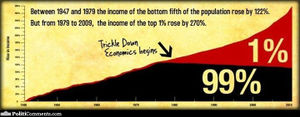The one percent
Jump to navigation
Jump to search
About
The 1% refers specifically to the top 1% of earners in any given economy -- most commonly the United States, but it can also refer to other countries or even the global economy. More generally, it refers to the fact that a very small segment of society owns a disproportionately large percentage of society's wealth, a disproportionality which intensifies as you look at smaller and smaller pieces of the top percentiles.
This disproportionality is an effect of economic disparity, which has been increasing continuously since the late 1970s when employee wages stopped reflecting continued productivity gains.
Statistics
- (2012 Super-PACs) The top 1% of donors (about 94 donors) give 54% of the money. [1]
- The gross domestic product of the poorest 48 nations is less than the wealth of the world's richest 3 people. (from image-meme; source needed)
- In 2009, the Forbes 400 -- the wealthiest 0.0000035% of Americans -- have more wealth than the bottom 50% combined. PolitiFact
- In 2010, they had more wealth than the bottom 60% combined -- more than 100 million households.
- The Wal-Mart heirs alone have more wealth than the bottom 40% combined. PolitiFact
- The economic top one percent of the population now owns over 70% of all financial assets, an all time record. AlterNet
Related
Links
- 2010-02-16 The Richest 1% Have Captured America's Wealth -- What's It Going to Take to Get It Back? "In 1970, CEOs made $25 for every $1 the average worker made. Due to technological advancements, production and profit levels exploded from 1970 - 2000. With the lion's share of increased profits going to the CEO's, this pay ratio dramatically rose to $90 for CEOs to $1 for the average worker. [..] As ridiculous as that seems, an in-depth study in 2004 on the explosion of CEO pay revealed that, including stock options and other benefits, CEO pay is more accurately $500 to $1." ... "The economic top one percent of the population now owns over 70% of all financial assets, an all time record."
